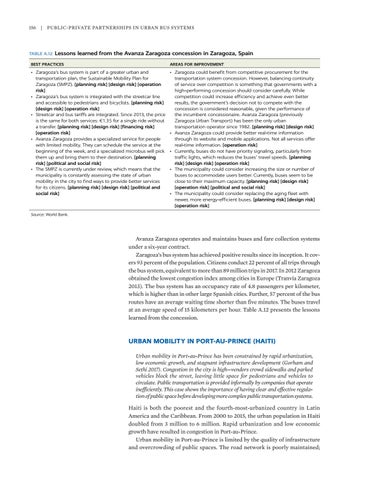156 | Public-Private Partnerships in Urban Bus Systems
TABLE A.12 Lessons
learned from the Avanza Zaragoza concession in Zaragoza, Spain
BEST PRACTICES
AREAS FOR IMPROVEMENT
• Zaragoza’s bus system is part of a greater urban and transportation plan, the Sustainable Mobility Plan for Zaragoza (SMPZ). [planning risk] [design risk] [operation risk] • Zaragoza’s bus system is integrated with the streetcar line and accessible to pedestrians and bicyclists. [planning risk] [design risk] [operation risk] • Streetcar and bus tariffs are integrated. Since 2013, the price is the same for both services: €1.35 for a single ride without a transfer. [planning risk] [design risk] [financing risk] [operation risk] • Avanza Zaragoza provides a specialized service for people with limited mobility. They can schedule the service at the beginning of the week, and a specialized microbus will pick them up and bring them to their destination. [planning risk] [political and social risk] • The SMPZ is currently under review, which means that the municipality is constantly assessing the state of urban mobility in the city to find ways to provide better services for its citizens. [planning risk] [design risk] [political and social risk]
• Zaragoza could benefit from competitive procurement for the transportation system concession. However, balancing continuity of service over competition is something that governments with a high-performing concession should consider carefully. While competition could increase efficiency and achieve even better results, the government’s decision not to compete with the concession is considered reasonable, given the performance of the incumbent concessionaire. Avanza Zaragoza (previously Zaragoza Urban Transport) has been the only urban transportation operator since 1982. [planning risk] [design risk] • Avanza Zaragoza could provide better real-time information through its website and mobile applications. Not all services offer real-time information. [operation risk] • Currently, buses do not have priority signaling, particularly from traffic lights, which reduces the buses’ travel speeds. [planning risk] [design risk] [operation risk] • The municipality could consider increasing the size or number of buses to accommodate users better. Currently, buses seem to be close to their maximum capacity. [planning risk] [design risk] [operation risk] [political and social risk] • The municipality could consider replacing the aging fleet with newer, more energy-efficient buses. [planning risk] [design risk] [operation risk]
Source: World Bank.
Avanza Zaragoza operates and maintains buses and fare collection systems under a six-year contract. Zaragoza’s bus system has achieved positive results since its inception. It covers 93 percent of the population. Citizens conduct 22 percent of all trips through the bus system, equivalent to more than 89 million trips in 2017. In 2012 Zaragoza obtained the lowest congestion index among cities in Europe (Tranvía Zaragoza 2013). The bus system has an occupancy rate of 4.8 passengers per kilometer, which is higher than in other large Spanish cities. Further, 57 percent of the bus routes have an average waiting time shorter than five minutes. The buses travel at an average speed of 15 kilometers per hour. Table A.12 presents the lessons learned from the concession.
URBAN MOBILITY IN PORT-AU-PRINCE (HAITI) Urban mobility in Port-au-Prince has been constrained by rapid urbanization, low economic growth, and stagnant infrastructure development (Gorham and Sethi 2017). Congestion in the city is high—vendors crowd sidewalks and parked vehicles block the street, leaving little space for pedestrians and vehicles to circulate. Public transportation is provided informally by companies that operate inefficiently. This case shows the importance of having clear and effective regulation of public space before developing more complex public transportation systems.
Haiti is both the poorest and the fourth-most-urbanized country in Latin America and the Caribbean. From 2000 to 2015, the urban population in Haiti doubled from 3 million to 6 million. Rapid urbanization and low economic growth have resulted in congestion in Port-au-Prince. Urban mobility in Port-au-Prince is limited by the quality of infrastructure and overcrowding of public spaces. The road network is poorly maintained;

